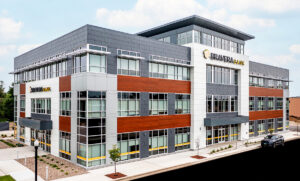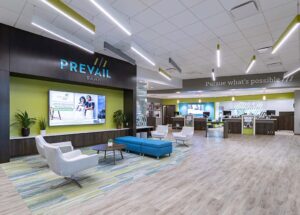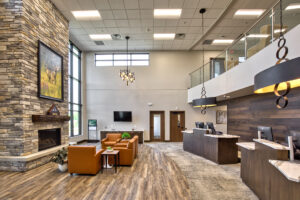Community bankers and industry consultants say branches are having a bit of a comeback, albeit with slightly less square footage and more personalized services.
Take Dickinson, N.D.-based Bravera Bank. The $2.5 billion bank opened a new, 47,200-square-foot administrative building with a retail lobby in 2021 in Dickinson. The building includes teller pods near its two main entrances. The ceiling of the bank lobby is twice as tall as other rooms, a design which floods the inside of the building with natural light and provides a connection with customer-facing areas on the second floor. The third floor includes a large bank training area.

The new space allows bankers, wealth managers and insurance staff to interact with each other on the second floor, something they lacked before. The third floor includes extensive administrative space.
“Certainly getting them together helped with our growth in that market, and we have seen good growth, because we try to get cross-referrals from those businesses as much as we can,” noted CEO Dave Ehlis. “And getting them all into one building made a big difference.”
The branch is in close proximity to the former administrative building, which had more than 50,000 square feet of space but was nearing the end of its life and not conducive to space efficiencies, Ehlis noted. Bank leadership was split between offices in Dickinson and Bismarck, 100 miles to the east.
“We actually downsized just a bit, but modern offices don’t have to be as big as offices were 20, 30-plus years ago, because we don’t store paper files and things like that,” Ehlis said. “We did things like make the individual offices a bit smaller, more conference rooms, more meeting spaces, just a new, modern footprint to help us reduce the size of the square footage.”
The process to build the facility took approximately a year from planning to completion. The bank appointed a program manager who then formed the business case. The Redmond Co. Financial Design Manager Sara Lepich met with the bank early in the process. Each department established a 10-year programming forecast along with a summary of work needs, and then Bravera started the design process. Bravera left approximately 5,000 square feet unfinished in the new building to prepare for potential expansion.
Ehlis advised other bankers considering construction projects to work with an outside consultant during the process. “Pick a partner, a marketing or advertising agency that does it, because they are just going to bring an element of professionalism to it that you probably cannot replicate on your own,” Ehlis said.
“You are going to have people within your own company who are going to question it. You have to sort of push past that and just do it.”
Footprints shrink but won’t disappear
The Bravera project symbolizes current bank architecture trends, Lepich said. Banks are prioritizing natural light and a friendly, open environment for customers and employees. They are also implementing open floor plans with transaction spaces near their entrances.

remodeled main office in
Medford, Wis., includes accents of the bank’s brand colors in furniture, lighting and flooring. (Photo courtesy of The Redmond Company)
“Creating a really nice, open atmosphere,” Lepich said, “with lots of daylight and views for the people who are using the building creates a nicer space overall, not just for the customers who are coming in, but also for the employees.”
Technology has changed the functions of a branch, she noted. As transactions move online, branches are increasingly used to handle in-person account resolutions or meeting an employee for a new service. There are also more customer amenities in today’s branches — lounge spaces, coffee bars and media screens for connections, including community-related artwork and graphics.
“Day-to-day transactions don’t necessarily need to happen within the branch itself, so that really changes the user dynamic of the branch,” Lepich said. “People are coming in more for problem resolution, or to maybe open an account or talk about a loan.”
Banks are now building smaller, 1,500- to 2,000-square-foot branches, noted Adam Holmes, CEO of Minneapolis-based Vanman Architects. Those that are reducing their square footage but remaining in the same building are establishing spaces for businesses or the community to gather and are bringing in complementary services such as insurance agents or financial advisers.
Two recent Vanman projects highlight this trend. A 7,500-square-foot building for Sherburne State Bank in downtown St. Cloud, Minn., features a stucco exterior, a glass curtain wall, and brick with granite paneling, a nod to St. Cloud’s designation as the “Granite City.” In Grand Rapids, Minn., a 13,000-square-foot branch of Woodland Bank includes a deck that can host cocktail receptions and employee lunches. As a community business center, the building is complete with an attorney’s office and coffee bar and meeting space for customers, nonprofits and other community groups.

The turn toward open concierge stations rather than traditional teller lines continues, with the addition of adjacent workspaces so employees can perform multiple tasks, Holmes noted. Banks undertaking interior renovations are moving their teller lines closer to the drive-thru window, allowing frontline staff to tend to both.
Many banks are expanding their branch network with multiple smaller branches, noted HTG Architects President Sean Raboin. This is especially useful as banks struggle to find staff and as cost-effective, self-service technology gains a foothold in the industry. There are largely three reasons for larger-footprint offices, Raboin noted: To offer more services, to serve a larger demographic or to co-brand with another company. Branches must still be accessible, preferably in heavily-trafficked areas of a community near other retail offerings.
While the number of branches continues to decrease as customers increasingly turn to digital tools, that trend has slowed as the industry works out the right balance between the two methods.
Making the most of your space
Bankers should be aware that every part of their branch presents a messaging opportunity to educate customers about their offerings, according to consulting firm Bancography. This could include a poster on a wall highlighting a new home equity product, a kiosk that includes marketing collateral, or a television screen showing stories of branch staff serving as community volunteers.

square foot facility in Grand Rapids, Minn., for Baldwin, Wis.-based Pillar Bank. The building, completed in 2023, features 4,000 square feet of space for the bank and 1,000 square feet of space for Caribou Coffee. (Photo courtesy of HTG Architects)
“For smaller facilities that lack sufficient space for external activities, consider community memo boards to advertise local events, or decorating with works of local artists — perhaps even featuring an artist of the quarter, with works available for purchase,” according to the firm.
Physical prominence, through positioning, design and exterior signage, also warrants attention so that the branch can be an effective billboard for the company. Some branches spotlight a business of the month, which allows commercial clients to promote their offerings.
“In more complex forms, this can progress to interactive kiosks and touch-screen wall displays where consumers can compare product options, or test drive the bank’s mobile and online banking platforms,” according to Bancography. “The overarching goal remains to increase consumers’ knowledge of the institution’s offerings.”
Another consideration for banks is the interior design scheme. According to Mental Health America, bright, warm colors can spark energy, making them effective in meeting rooms. Cooler tones are better suited for quieter spaces such as break rooms. Natural lighting is the No. 1 element employees desire in their working environments, according to Harvard Business Review. Nearly half of employees reported feeling tired from a lack of natural light or a window in their office, with 43 percent feeling gloomy because of an absence of light.
Bravera Bank’s new administrative building maximizes natural lighting in both work spaces and a large conference training room. The bank has added elements of yellow into its broader branch network, but the color palette for the facilities also includes warmer blues, grays and yellows.
“We had a local remodel that we had established, so we wanted that to be our standard moving forward,” said Marketing Manager Kelsey Dahl. “That being said, we were also in the midst of a rebrand, so we knew that we wanted a color palette that would be everlasting but still work with our rebrand after changing our name and our main color palette.”
